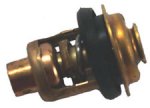toneeees
Administrator
- Joined
- Mar 15, 2011
- Messages
- 3,024
Article by Tim Banse, Marine Engine Digest
Overheating is a major cause of death for marine engines,
including gas and diesel stern drives, inboards and outboard motors. In fact some industry statistics say as many of 70% of all premature engine deaths emanate from the malady. Saving the day, some modern power plants have engine warning systems that literally sound the alarm when the temperature begins to rise towards dangerous temperatures. When that happens, onboard firmware automatically reduces rpm so the boat can, in most cases, limp home. That technology is a great fail safe. But what would be even better is some kind of plan to prevent the overheating in the first place. With that in mind here are some ideas to keep in mind.
Overheating is a major cause of death for marine engines,

including gas and diesel stern drives, inboards and outboard motors. In fact some industry statistics say as many of 70% of all premature engine deaths emanate from the malady. Saving the day, some modern power plants have engine warning systems that literally sound the alarm when the temperature begins to rise towards dangerous temperatures. When that happens, onboard firmware automatically reduces rpm so the boat can, in most cases, limp home. That technology is a great fail safe. But what would be even better is some kind of plan to prevent the overheating in the first place. With that in mind here are some ideas to keep in mind.
- Most of the time engines overheat because the impeller isn't pumping water to the cylinder block and heads. So naturally it follows - keeping track of impeller health is a good idea. On inboards and stern drives that can be as simple as removing the inspection cover and looking at it. You don't necessarily have to remove it. Visually determine whether all of the blades are present. And are any of the blades showing cracks or checkering? If so don't hesitate to replace the worn impeller at once. Not only is it in danger of complete failure, when blades strip off they flow downstream into the engine where they could obstruct cooling flow.
- Another important checkpoint is the raw water filter.
 Go to the trouble of making sure it's not plugged. At the same time check all of the cooling system hoses, one at a time. Start at the hull thru fitting. Visually inspect the hoses with a flashlight looking for checkering or cracks, once again, clues that near term failure is possible. Next, squeeze each hose in turn. A cooling hose should feel supple, and not hard. Most of the time when you find a hardened hose it will be on the engine. That's because ambient engine heat hour after running hour has baked it to a crisp.
Go to the trouble of making sure it's not plugged. At the same time check all of the cooling system hoses, one at a time. Start at the hull thru fitting. Visually inspect the hoses with a flashlight looking for checkering or cracks, once again, clues that near term failure is possible. Next, squeeze each hose in turn. A cooling hose should feel supple, and not hard. Most of the time when you find a hardened hose it will be on the engine. That's because ambient engine heat hour after running hour has baked it to a crisp. - Outboard motor impellers are strategically located in the lower unit. The lower unit is exposed to sunlight, which over time can bake the impeller. Baked impellers have lost resilience. Hard impeller blades strip off. Also over time, and this includes inboard and stern drive impellers, impellers lose their flexibility and take a set - meaning the blades don't stick out from the hub at a 90 degree angle and are curved. When that happens they will still pump water, just not very much. Knowing that, some boat owners make a preemptive strike and remove and replace the impeller every two or three years.
- Another overheating culprit is the thermostat.

Sometimes they stick open, in which case the engine may not warm up to its normal operating temperature. And in other instances the thermostat sticks tight in the closed position. The good news is changing a thermostat is easy even for a fumble fingered do-it-yourselfer. - But what do you do when you think the engine is overheating and you don't have, or simply don't trust, the temperature gauge? The answer is as simple as the sea is salt. Shut down the engine for safety sake. Then carefully touch the cylinder head. You should almost, but not quite, be able to lay you hand on it. But if it is sizzling hot, there's an overheating problem. If you're squeamish about touching a warm engine, no problem, flick some water onto the engine and watch the results. If the water beads up and sizzles away into evaporation, there's a problem.
- There are other high tech solutions worth considering. For about $50 and up you can buy an infrared temperature gun. To use it, simply aim it at the work piece and squeeze the trigger. The temperature display tells you how hot it is. Also you should know about temperature crayons. They come denominated in different temperature ranges. With this method, scribe a mark with the crayon on the work piece. If the crayon residue melts then the temperature is as least the rating of the crayon.
- Besides the temp gauge, outboard motors also shoot

an indicator stream that shows the impeller is hard working. Sometimes when the stream stops it means the impeller is dead. Sometimes it just means the indicator streams plumbing is plugged up. That's why I have a two-foot section of 300-pound monofilament fish line under the cowling tied to the engine. If the stream stops, I jab the stiff monofilament into the orifice and clean it out. If water begins to flow anew, all is well. - Finally, the best prevention for engine overheating is to trust the temperature gauge and monitor it often. Consider rotating the temp gauge so its needle points straight up when registering normal engine temperature. Then if the temp begins to rise you'll see it immediately.iboats.com carries all brands of impellers, thermostats, hoses, gauges and more. - click here to shop engine parts.
Last edited by a moderator:



















